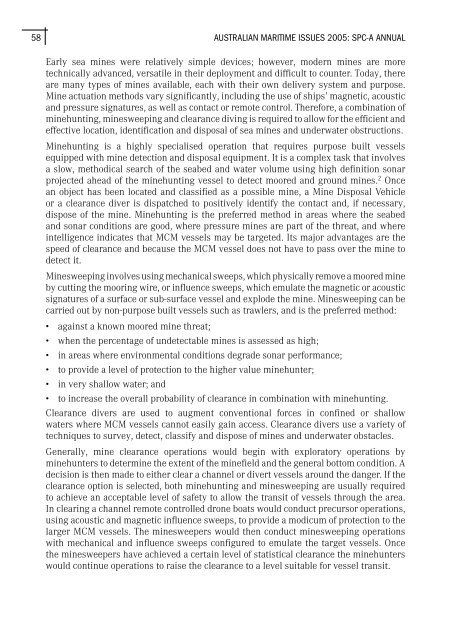Australian Maritime Issues 2005 - Royal Australian Navy
Australian Maritime Issues 2005 - Royal Australian Navy
Australian Maritime Issues 2005 - Royal Australian Navy
Create successful ePaper yourself
Turn your PDF publications into a flip-book with our unique Google optimized e-Paper software.
58<br />
AUSTRALIAN MARITIME ISSUES <strong>2005</strong>: SPC-A ANNUAL<br />
Early sea mines were relatively simple devices; however, modern mines are more<br />
technically advanced, versatile in their deployment and difficult to counter. Today, there<br />
are many types of mines available, each with their own delivery system and purpose.<br />
Mine actuation methods vary significantly, including the use of ships’ magnetic, acoustic<br />
and pressure signatures, as well as contact or remote control. Therefore, a combination of<br />
minehunting, minesweeping and clearance diving is required to allow for the efficient and<br />
effective location, identification and disposal of sea mines and underwater obstructions.<br />
Minehunting is a highly specialised operation that requires purpose built vessels<br />
equipped with mine detection and disposal equipment. It is a complex task that involves<br />
a slow, methodical search of the seabed and water volume using high definition sonar<br />
projected ahead of the minehunting vessel to detect moored and ground mines. 2 Once<br />
an object has been located and classified as a possible mine, a Mine Disposal Vehicle<br />
or a clearance diver is dispatched to positively identify the contact and, if necessary,<br />
dispose of the mine. Minehunting is the preferred method in areas where the seabed<br />
and sonar conditions are good, where pressure mines are part of the threat, and where<br />
intelligence indicates that MCM vessels may be targeted. Its major advantages are the<br />
speed of clearance and because the MCM vessel does not have to pass over the mine to<br />
detect it.<br />
Minesweeping involves using mechanical sweeps, which physically remove a moored mine<br />
by cutting the mooring wire, or influence sweeps, which emulate the magnetic or acoustic<br />
signatures of a surface or sub-surface vessel and explode the mine. Minesweeping can be<br />
carried out by non-purpose built vessels such as trawlers, and is the preferred method:<br />
• against a known moored mine threat;<br />
• when the percentage of undetectable mines is assessed as high;<br />
• in areas where environmental conditions degrade sonar performance;<br />
• to provide a level of protection to the higher value minehunter;<br />
• in very shallow water; and<br />
• to increase the overall probability of clearance in combination with minehunting.<br />
Clearance divers are used to augment conventional forces in confined or shallow<br />
waters where MCM vessels cannot easily gain access. Clearance divers use a variety of<br />
techniques to survey, detect, classify and dispose of mines and underwater obstacles.<br />
Generally, mine clearance operations would begin with exploratory operations by<br />
minehunters to determine the extent of the minefield and the general bottom condition. A<br />
decision is then made to either clear a channel or divert vessels around the danger. If the<br />
clearance option is selected, both minehunting and minesweeping are usually required<br />
to achieve an acceptable level of safety to allow the transit of vessels through the area.<br />
In clearing a channel remote controlled drone boats would conduct precursor operations,<br />
using acoustic and magnetic influence sweeps, to provide a modicum of protection to the<br />
larger MCM vessels. The minesweepers would then conduct minesweeping operations<br />
with mechanical and influence sweeps configured to emulate the target vessels. Once<br />
the minesweepers have achieved a certain level of statistical clearance the minehunters<br />
would continue operations to raise the clearance to a level suitable for vessel transit.

















